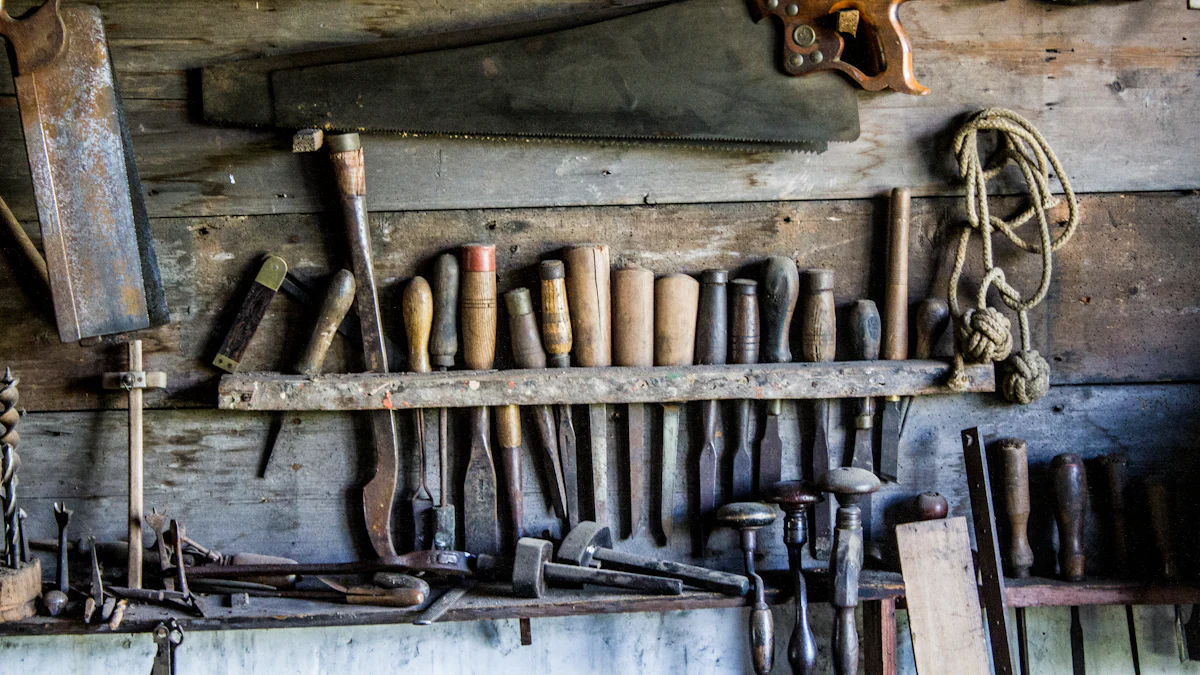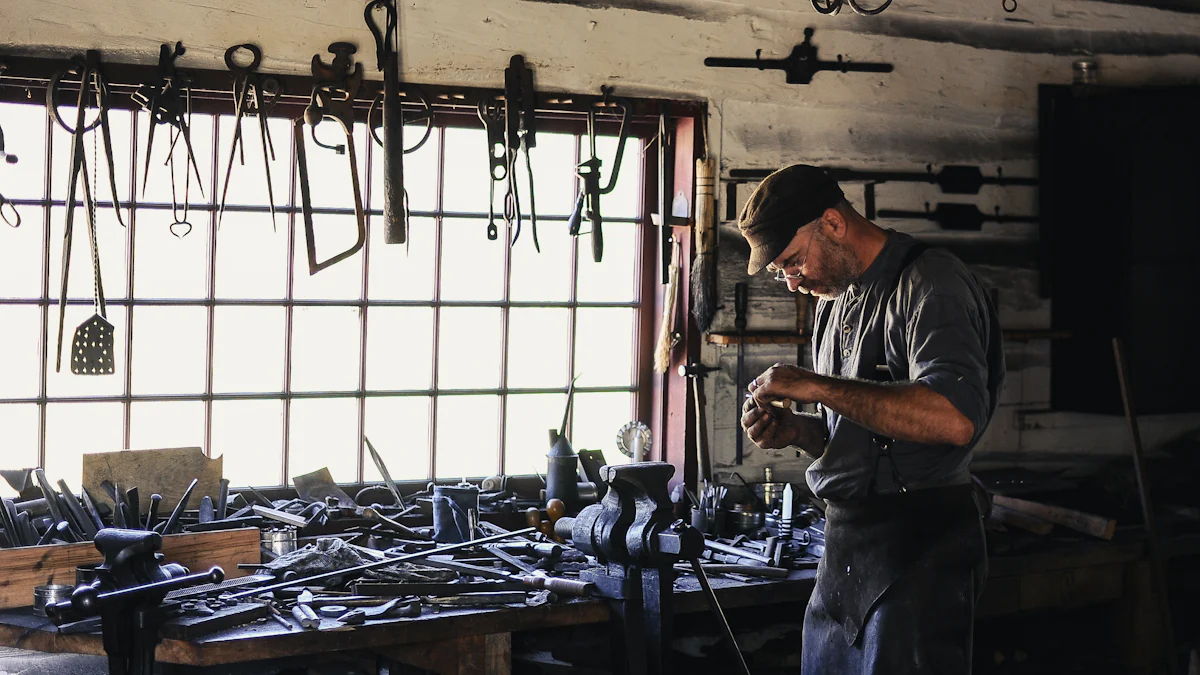
Amish craftsmanship stands as a testament to tradition and skill. The Amish community places immense value on hand tools, which play a crucial role in their culture. These tools allow craftsmen to achieve precision and detail in their work. The reliance on amish hand tools ensures the preservation of techniques passed down through generations. Amish artisans use planes, chisels, and saws to shape and refine wood. This dedication to manual labor highlights the Amish commitment to quality and tradition. The crafting process involves meticulous attention to detail, emphasizing patience and the natural beauty of materials.
The Uniqueness of Amish Woodworking
Historical Context
Origins of Amish craftsmanship
Amish craftsmanship began with the early settlers in America. These settlers brought woodworking skills from Europe. The Amish community valued self-sufficiency and resourcefulness. Woodworking became a vital part of their daily life. The Amish used local materials to create essential tools and furniture. This practice laid the foundation for their unique craftsmanship.
Evolution over time
Amish woodworking evolved over centuries. The community maintained traditional techniques. These techniques included dovetail joints and mortise-and-tenon joinery. Such methods ensured durability and strength. The Amish adapted to new environments while preserving their heritage. Their craftsmanship became renowned for its quality and timeless appeal.
Key Characteristics
Use of manual tools
Amish craftsmen rely on manual tools. These tools include chisels, planes, saws, and hammers. Each tool serves a specific purpose in woodworking. Manual tools allow for precision and control. The Amish avoid using electricity in their workshops. This choice reflects their commitment to tradition and simplicity.
Emphasis on quality and durability
Amish woodworking emphasizes quality and durability. Craftsmen select high-quality materials for each project. The construction process avoids nails and screws. Instead, traditional joinery techniques enhance strength. Hand-finishing highlights the natural beauty of the wood. Every piece reflects meticulous attention to detail. The result is functional art that stands the test of time.
Specific Amish Hand Tools

Commonly Crafted Tools
Woodworking tools
Amish craftsmen rely heavily on amish hand tools for woodworking. Chisels, planes, saws, and hammers form the core of their toolkit. Chisels allow artisans to carve intricate designs into wood. Planes smooth surfaces, preparing them for finishing. Saws provide precise cuts, essential for accurate assembly. Hammers assist in shaping and joining pieces together. Each tool serves a specific function, contributing to the overall quality of the craftsmanship.
Farming tools
The Amish community also crafts amish hand tools for farming. These tools include plows, hoes, and scythes. Plows break up soil, preparing it for planting. Hoes help in weeding and cultivating crops. Scythes cut grass and harvest grains. Each tool reflects the Amish commitment to sustainability and efficiency in agriculture. The use of these tools ensures that farming remains a hands-on, labor-intensive process.
Crafting Process
Selection of materials
Amish artisans prioritize the selection of high-quality materials. Wood is harvested sustainably from local sources. Craftsmen choose materials based on durability and aesthetic appeal. The selection process involves careful inspection for defects. Only the best materials make it to the crafting stage. This attention to detail ensures that amish hand tools last for generations.
Techniques used in crafting
The crafting of amish hand tools involves traditional techniques. Artisans employ methods like dovetail joints and mortise-and-tenon joinery. These techniques enhance the strength and longevity of the tools. Craftsmen use steam bending to shape wood without weakening it. Hand carving adds intricate details to each piece. The final step involves meticulous sanding and polishing. This process highlights the natural beauty of the wood grain. The result is a tool that combines functionality with artistry.
Styles and Significance
Traditional Styles
Influence of Amish beliefs
Amish beliefs shape the creation of amish hand tools. The Amish community values simplicity and functionality. These values reflect in the straightforward design of their tools. Religious beliefs influence the crafting process. The Amish avoid unnecessary embellishments. This approach ensures that each tool serves its purpose efficiently. The focus remains on practicality and durability. The tools embody the Amish commitment to a humble lifestyle.
Regional variations
Regional differences impact the style of amish hand tools. Various Amish communities develop unique aesthetics. Local resources influence the choice of materials. Different regions have access to different types of wood. These variations result in distinct styles and designs. The craftsmanship reflects the environment and available resources. Each region showcases its own interpretation of Amish traditions. The diversity adds richness to Amish woodworking.
Cultural and Practical Significance
Role in Amish daily life
Amish hand tools play a vital role in daily life. The Amish rely on these tools for various tasks. Woodworking and farming require different tools. Each tool contributes to the community’s self-sufficiency. The use of hand tools emphasizes manual labor. This practice fosters a deep connection with the work. The tools symbolize the Amish way of life. The dedication to craftsmanship reflects cultural values.
Impact on modern woodworking
Modern woodworking benefits from amish hand tools. The emphasis on quality and durability inspires contemporary artisans. Many woodworkers adopt Amish techniques. The use of traditional joinery enhances modern designs. The focus on sustainability influences current practices. Amish craftsmanship sets a standard for excellence. The legacy of amish hand tools continues to impact the woodworking industry. The tools serve as a bridge between past and present.
Amish craftsmanship showcases a meticulous crafting process. Artisans select high-quality materials and employ traditional techniques. Each tool reflects the dedication to quality and durability. The cultural importance of Amish hand tools extends beyond functionality. These tools embody values like tradition, self-sufficiency, and community. Each piece crafted by Amish artisans carries a unique character and soul. The enduring legacy of Amish craftsmanship continues to inspire. Modern woodworkers draw from Amish techniques and values. The influence of Amish hand tools persists in today’s woodworking industry.
